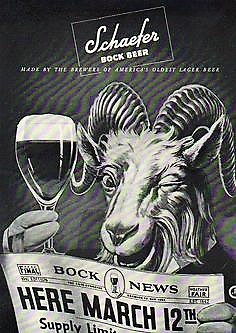
Before and after Prohibition, bock beer was a favorite ale that was available for only a short time every year around March and April (hence, it was called the Easter beverage). A goat was almost always featured in bock beer posters (“bock” is a “billy goat” in German).
The Big Apple, the City That Never Sleeps, the City of Dreams. The city so nice, they named it twice has its share of nicknames. One of my favorites is perhaps its most obscure nickname: Gotham.
Gotham is reportedly tied to Washington Irving, author of “The Legend of Sleepy Hollow” and “Rip Van Winkle.” Irving was the ringleader of a group known as the Lads of Kilkenny, a group that author Edwin Burrows describes as “a loosely knit pack of literary-minded young blades out for a good time” in his book “Gotham: A History of New York City to 1898.”
The Lads established a literary magazine called Salmagundi in 1807, in which they published essays concerning events in “the thrice renowned and delectable city of Gotham.” It was reportedly these references that led to the city’s nickname.
According to the New York Public Library, the word “Gotham” actually dates back to medieval England. English proverbs tell of a village called Gotham or Gottam, which means “Goat’s Town” in old Anglo-Saxon. Old folk tales from the Middle Ages suggest that Gotham was the village of simple-minded fools, perhaps because the goat was considered a foolish animal.
The goat in the following animal tale of old Gotham may have been foolish, but he was known more for his beauty – if one can call a goat beautiful.
The Bock Beer Goat Beauty Contest
For hundreds of years, perhaps even going back to fifteenth-century beer signs in the town of Einbeck in the old Kingdom of Hannover (now Saxony), a goat has been featured on bottles, posters, and advertisements for bock beer (Einbeck bier was pronounced “ein bock” by Munich beer drinkers).
The beer and its goat disappeared in the United States during Prohibition, but it made a grand comeback in 1934. That year, all five city boroughs and the city of Newark, New Jersey, held competitions to find a goat whose portrait would grace the posters announcing the return of what was once the recognized Easter beverage. The contests were sponsored by the Brewers Board of Trade, which sought beautiful billy goats to adorn their advertising posters (no nanny goats need apply).
Up to 100 goats were entered in the preliminary contests, including mascots and talismans. The mascots were kept by secret societies and other groups for whom the mere fact of keeping a goat was comical. The talismans were kept by kennels and stables on the theory that no animal could get distemper if a goat was somewhere nearby.
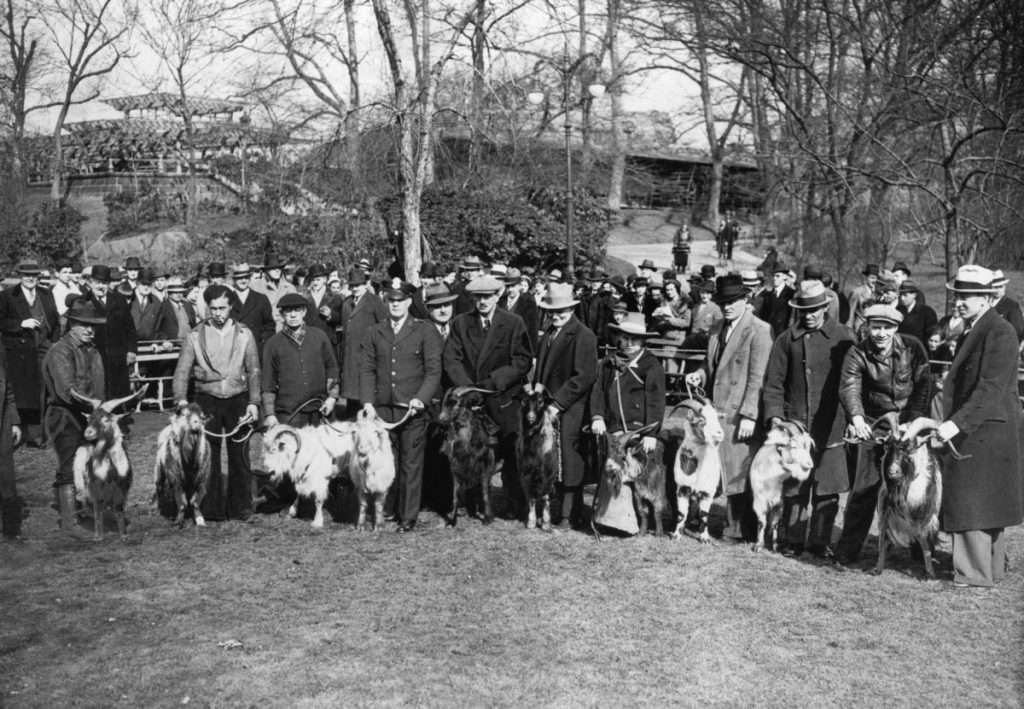
Contestants line up for the Bock Beer Goat Beauty Pageant in Central Park.
The preliminary contests took place on the Heckscher Playground in Central Park, at the Bronx Park ball field, at the Prospect Park Parade Ground in Brooklyn, at Clove Lake in Staten Island, and in Newark, New Jersey. Queens was not allowed to participate in the goat games due to a lack of contestants; Brooklyn, which once had an abundance of goats, was also a disappointment with only two contestants.
The five first-place winners of the preliminary borough competitions–who were crowned “Mr. Manhattan,” “Mr. Bronx,” etc.–were invited to compete a week later at Central Park for the grand prize, which was a check for $75, a loving cup, a blanket, and the title “Mr. Bock Beer, 1934.”
In the preliminary contests, which took place on St. Patrick’s Day, all the goats were tethered in a roped-off enclosure and judged from an aesthetic viewpoint, with the length of beard counting rather heavily in the contestant’s favor. The judges in Central Park were David Mayer, who owned a goat ranch on Long Island and was a member of the American Milk Goat Record Association, and Arthur Hill, who worked for the National Broadcasting Company (NBC). All of the goats reportedly had name tags, except those that had eaten them.
In Central Park, there were four performing goats among the entrants, including one named Julia (wouldn’t she have been disqualified as a nanny?) who broke through the line of spectators and made for the rocks. Another goat named Hiram Abiff was also disqualified for butting judge Mayer and several spectators.
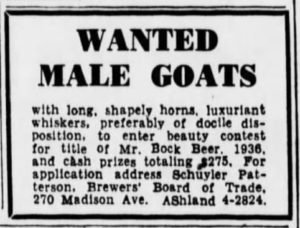
This ad seeking beautiful goats appeared in the Brooklyn Daily Eagle in March 1936.
In 1934, Pretzels, a Tannenburg goat, was crowned “Mr. Manhattan,” even though he did not live in Manhattan (the New York Times noted that he won on a technicality because his owner, John Dunn, resided at 601 West 26th Street). He received a $25 prize and the right to compete with the other goats for the prestigious “Mr. Bock Beer” title. Second place in Manhattan went to Joe, a Rocky Mountain Angora goat and mascot of Squadron 8, 101st Cavalry.
The first- and second-place winners in the other boroughs were as follows:
John Cristens, 430 East 165th Street, and Joe Caruso, 89 Coscob Avenue (Bronx); Giuseppe Collesano, 158 Hett Avenue, New Dorp, and Anthony Siclardi, 149 Jefferson Avenue, Dongan Hills (Staten Island); Don Debue, 1 Vauxhall Street, and Edward Eschman, West Orange, NJ (Newark); Mrs. Carolyn Dickson, 44 Truckelman Lane, and Max Clark, 108½ Douglas Street (Brooklyn).
Pretzels, Mr. Bock Beer
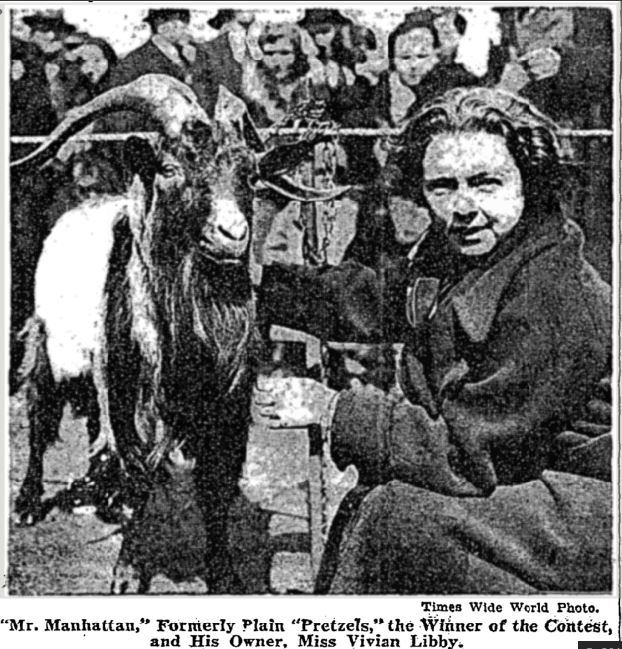
Three-year-old Pretzels with his handler, Miss Vivian Libby, after being crowned “Mr. Manhattan” in 1934. (Pretzels’ owner of record was John Dunn of Manhattan.)
“A non-resident goat from Hastings-on-the-Hudson won out over twenty-three nervous but native competitors yesterday in the Bock Beer Beauty Contest in Central Park. The other goats had citizenship, but Pretzels had beauty, which overleaps the barriers of time, space and nationality.”–New York Times, March 18, 1934
Pretzels was born and raised on an estate in Hastings-on-Hudson, where he spent all his life living in warm heated barns and grazing in green pastures (when not strutting his stuff in beauty pageants).
Pretzels was under the care of Chester Lieb, a chemist. According to Lieb, Pretzels weighed 140 pounds, stood three feet from hoof to horn tip, had a horn spread of two feet, a one-foot-long beard, and a “massive chest” measuring 36 inches. (Donald Trump, eat your heart out.) Pretzels also had about 30 kids among his progeny, including a son named Pretzels Jr. who competed in the Bronx goat beauty pageant.
The 1934 Bock Beer Goat Beauty Pageant
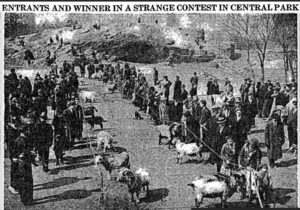
The goats were judged for their beauty, length of beard, and disposition.
In 1934, the judges for the final competition were all artists: Uncle Sam-drawing James Montgomery Flagg, Otto Soglow, Tony Sarg, Dean Cornwell, Frank Godwin, August W. Hutaf, and Billy B. Van. Many of the contestants questioned their qualifications for judging goats. Flagg said his knowledge of Gene Buck and Frank Buck was qualification enough. Godwin said that art editors had gotten his goat for years. And Cornwell said he was once a goat, so that qualified him to be a judge.
About 100 men, women, and children came out to witness the contest at the Heckscher Playground. No surprise, most of the observers were kids.
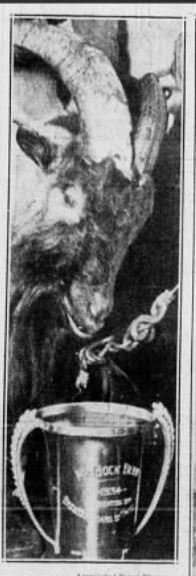
Pretzels licked the loving cup a few times, but he lost interest when he discovered it was not edible.
As expected, Pretzels was crowned “Mr. Bock Beer, 1934.” Second prize went to Mr. Bronx, owned by John Cristens. Pretzels was reportedly not too thrilled with the inedible loving cup, but he did take a few bites of his new blanket.
The contest didn’t get any publicity in 1935 (Pretzels won again, which allowed him to participate as the grand marshal in a bock beer parade at City Hall that year), but the Manhattan pageant in 1936 featured 18 entries, including Pretzels and Jerry, the mascot of a stable at 620 West 48th Street. (More on Jerry to come in another post.)
That year Buddy, a goat used as a lawn mower by the Standard Oil Company of New Jersey to level grass around its huge oil tanks, won first prize as “Mr. Bock Beer, 1936.” Buddy attended the competition with his bodyguard, former welterweight fighter Johnny “Kid” Alberts. Of course.
Second prize went to Buckeye, a goat owned by 11-year-old Bill McCool of Hillside, N.J. Buckeye lived on the McCool’s farm in Henryville, PA and competed in the Newark preliminary round.
There were no additional goat beauty pageants after 1936 — at last none that I could find. I don’t know what happened to Pretzels, but I’m sure he lived out his life in luxury in Hastings-on-Hudson.
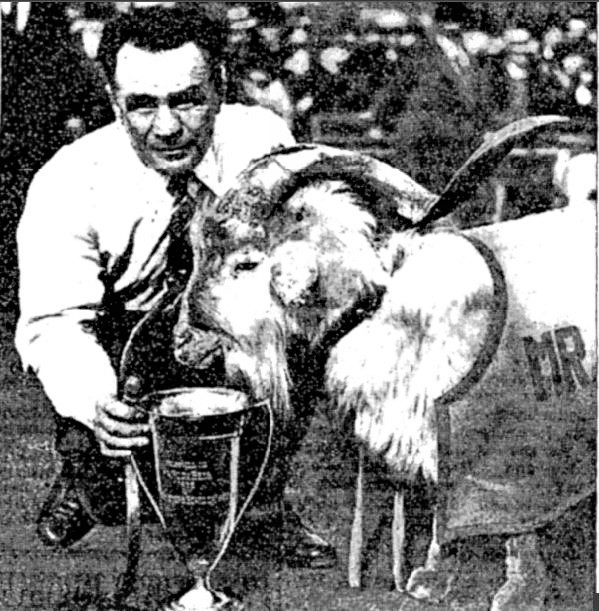
Buddy with “Kid” Alberts in 1936.



